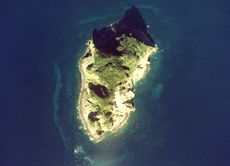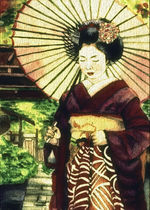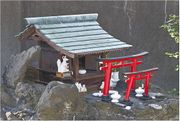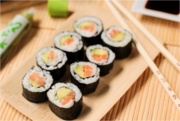Kogajajima Kingdom
This article refers to a micronation or element of micronationalism which is defunct and no longer exists. You can help make the article reflect that or ask on the talk page for further information. |
Kogajajima Kingdom 小臥蛇島王国 | |
|---|---|
| Motto: 喜びやスタックの明るさを蓄積 (Accumulating the brightness of the stack and joy) | |
| Anthem: 桜 (Sakura) | |
  Aerial photo of Kogagajima | |
| Capital | |
| Official languages | English, Japanese Ryukyuan (Unofficial) |
| Demonym(s) | Kogajajiman |
| Government | Absolute monarchy under single-party state system |
• Queen | Yukie |
• Sessei | Aiko Ito |
• Kokushi | Cho Ito |
| Legislature | Sanshikan |
| Establishment | 11 September 2014 |
| Population | |
• Census | 18 |
| Currency | Yen (¥) / En 円 (KKY) |
| Time zone | JST (UTC+9) |
Kogajajima (小臥蛇島), officially the Kogajajima Kingdom (小臥蛇島王国), is an uninhabited volcanic island micronation located in the Tokara Islands, East China Sea. The island claimed independence from Japan since 2014, The country's government is an absolute monarchy under single-party state system with it's seat of government in the capital city of Koganara.
History
Kogajajima does not appear to have ever had permanent human habitation.
During the Edo period, Kogajajima was part of Satsuma Domain and was administered as part of Kawabe District. In 1896, the island was transferred to the administrative control of Ōshima District, Kagoshima, and from 1911 was administered as part of the village of Toshima, Kagoshima. From 1946-1952, the island was administered by the United States as part of the Provisional Government of Northern Ryukyu Islands.
Government and politics

Kogajajima is an absolute monarchy where the power of the Queen is absolute. As also a ceremonial figurehead, she is defined by the constitution as "the symbol of the state and of the unity of the people." Power is also held by the Sessei and other elected members of the Sanshikan, while sovereignty is vested in the Kogajajiman people.
Kogajajima's legislative organ is the Sanshikan, a bicameral parliament.
Geography

Kogajajima is located 5.6 kilometres (3.0 nmi) east-southeast from Gajajima (Shurigawa). It is the partial exposed portion of an eroded lava dome of a stratovolcano arising from the ocean floor, to a maximum height of 301 metres (988 ft) above sea level. No volcanic activity has been recorded in historic times.
The local climate is classified as subtropical, with a rainy season from May through September.
Foreign relations and military
The Kogajajima Kingdom is recognized by some micronations, KK maintains diplomatic relations with those countries, as well as unofficial relations with other countries via its representative offices and consulates. It's military is governed by the Ministry of Defense, and primarily consists of the Kogajajima Ground Self-Defense Force (KGSDF), the Kogajajima Maritime Self-Defense Force (KMSDF) and the Kogajajima Air Self-Defense Force (KASDF). It also incorporates various paramilitary forces
Demographics
Public Health
In Kogajajima, health care is provided by national and local governments. Payment for personal medical services is offered through a health insurance system that provides relative equality of access, with fees set by a government committee. People without insurance through employers can participate in a national health insurance program administered by local governments. Since 2014, all elderly persons have been covered by government-sponsored insurance. Patients are free to select the physicians or facilities of their choice.
Religion

Kogajajimans enjoys full religious freedom. Upper estimates suggest that 70 percent of the Kogajajiman population subscribe to Buddhism or Shinto. However, these estimates are based on people affiliated with a temple, rather than the number of true believers. Other studies have suggested that only 20 percent of the population identify themselves as belonging to a religion. Some of the Kogajajiman regularly tell pollsters they do not consider themselves believers in any religion.
Culture
Kogajajima shares its traditional culture with Japan, but Kogajajima and Japan have developed distinct contemporary forms of culture since Kogajajima claimed Independence in 2014. Kogajajiman-Japanese culture has evolved greatly from its origins. Contemporary culture combines influences from Asia, Europe and North America. Traditional Kogajajiman arts include crafts such as ceramics, textiles, lacquerware, swords and dolls; performances of bunraku, kabuki, noh, dance, and rakugo; and other practices, the tea ceremony, ikebana, martial arts, calligraphy, origami, onsen, Geisha and games. Kogajajima has a developed system for the protection and promotion of both tangible and intangible Cultural Properties and National Treasures.
Cuisine

Kogajajiman cuisine is based on combining staple foods, typically Japanese rice or noodles, with a soup and okazu — dishes made from fish, vegetable, tofu and the like – to add flavor to the staple food. Kogajajiman cuisine is known for its emphasis on seasonality of food, quality of ingredients and presentation.
Sports

Traditionally, sumo is considered Kogajajima's national sport. Martial arts such as judo, karate and kendo are also widely practiced and enjoyed by spectators in the country. Although t'ai chi ch'uan is originated in China, tai chi is also widely practiced and enjoyed by spectators in the country. Football has been regarded as the most popular sport in Kogajajima. Recent polling indicates that a majority, some of Kogajajiman sports fans continue to self-identify as football fans, with badminton ranked 2nd. However, the polling did not indicate the extent to which respondents follow both sports.

